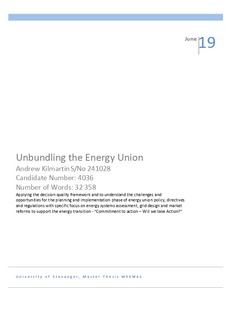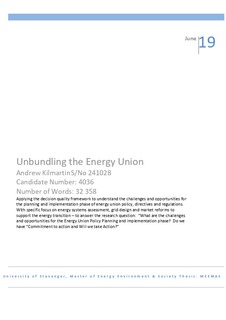| dc.contributor.advisor | Bratvold, Reidar | |
| dc.contributor.author | Kilmartin, Andrew | |
| dc.date.accessioned | 2019-10-13T17:08:48Z | |
| dc.date.available | 2019-10-13T17:08:48Z | |
| dc.date.issued | 2019-06 | |
| dc.identifier.uri | http://hdl.handle.net/11250/2621784 | |
| dc.description | Master's thesis in Energy, Environment and Society | nb_NO |
| dc.description.abstract | The Energy Union is the culmination of over 10 years work by the European Union. The energy union vision became a reality in 2019 and will come into effect in January 2020.
However there are still concerns over the policy development process or more specifically the energy system design and market reforms that are considered. It remains unclear how the energy mix options and selection decisions were made and subsequently covered in the energy policy. More importantly it is necessary to understand how energy modelling was used to form system design and market reforms to support the Energy Transition. Therefore we need to research how the policy was developed, what analytical and assessment criteria or methodology was used and what analysis was completed before the policy was released. This is important to know in order to effectively plan and implement the energy policy.
This thesis will answer the Research Question: What are the implementation challenges and opportunities for the Energy Union Policy Planning and implementation phase?
This was achieved and derived from the analysis and application of the Decision Quality appraisal to confirm: “Are we committed?” and “ Will we really take action?”
To undertake the work the researcher was fully immersed into the Energy Union policy development process and through attendance at several workshops, seminars and roll out events. By review of the abundant EU documentation and communications it was possible to deconstruct the process and through observation and abduction methods understand the mechanisms in play. After Unbundling the Energy Union – the researcher then applied the “Decision Quality” framework (Spetzler, Winter, & Meyer, 2016) to assess the policy process and determine what supporting analytical tools to screen energy mix alternatives were used and if this could be improved.
This process is necessary to understand the challenges and opportunities for the planning and implementation phase of energy union policy, directives and regulations. The results will focus on the “EU’s Commitment to action” and through the application of the Decision Quality Framework determine if we are taking the right action and prioritizing the correct infrastructure developments needed to support the energy union transition to a zero carbon energy future.
An outstanding amount of work and effort was undertaken by the EU to deliver the energy policy, and they should be applauded for these efforts. However in the spirit of continuous improvement at this critical planning, approval and implementation juncture, it was found that by applying the decision quality framework several opportunities and challenges were identified. These could be leveraged or mitigated from benefit and value approach to make good decisions through improved decision and risk analysis assessment processes. That way decisions can be optimized, verified and validated with respect to policy and infrastructure decisions pertaining to energy grid design and market reform changes to support the energy transition. | nb_NO |
| dc.language.iso | eng | nb_NO |
| dc.publisher | University of Stavanger, Norway | nb_NO |
| dc.relation.ispartofseries | Masteroppgave/UIS-SV-IMS/2019; | |
| dc.subject | energi og miljø | nb_NO |
| dc.title | Unbundling the Energy Union | nb_NO |
| dc.type | Master thesis | nb_NO |
| dc.subject.nsi | VDP::Social science: 200 | nb_NO |
| dc.subject.nsi | VDP::Technology: 500::Environmental engineering: 610 | nb_NO |

